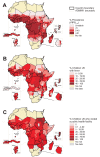Estimating the number of paediatric fevers associated with malaria infection presenting to Africa's public health sector in 2007
- PMID: 20625548
- PMCID: PMC2897768
- DOI: 10.1371/journal.pmed.1000301
Estimating the number of paediatric fevers associated with malaria infection presenting to Africa's public health sector in 2007
Abstract
Background: As international efforts to increase the coverage of artemisinin-based combination therapy in public health sectors gather pace, concerns have been raised regarding their continued indiscriminate presumptive use for treating all childhood fevers. The availability of rapid-diagnostic tests to support practical and reliable parasitological diagnosis provides an opportunity to improve the rational treatment of febrile children across Africa. However, the cost effectiveness of diagnosis-based treatment polices will depend on the presumed numbers of fevers harbouring infection. Here we compute the number of fevers likely to present to public health facilities in Africa and the estimated number of these fevers likely to be infected with Plasmodium falciparum malaria parasites.
Methods and findings: We assembled first administrative-unit level data on paediatric fever prevalence, treatment-seeking rates, and child populations. These data were combined in a geographical information system model that also incorporated an adjustment procedure for urban versus rural areas to produce spatially distributed estimates of fever burden amongst African children and the subset likely to present to public sector clinics. A second data assembly was used to estimate plausible ranges for the proportion of paediatric fevers seen at clinics positive for P. falciparum in different endemicity settings. We estimated that, of the 656 million fevers in African 0-4 y olds in 2007, 182 million (28%) were likely to have sought treatment in a public sector clinic of which 78 million (43%) were likely to have been infected with P. falciparum (range 60-103 million).
Conclusions: Spatial estimates of childhood fevers and care-seeking rates can be combined with a relational risk model of infection prevalence in the community to estimate the degree of parasitemia in those fevers reaching public health facilities. This quantification provides an important baseline comparison of malarial and nonmalarial fevers in different endemicity settings that can contribute to ongoing scientific and policy debates about optimum clinical and financial strategies for the introduction of new diagnostics. These models are made publicly available with the publication of this paper.
Conflict of interest statement
RWS chaired Novartis's National Malaria Control Programme Best Practice Workshops for several years in Africa for which he was paid an honorium. The need for defining drug commodity requirements by countries stems from these workshops. RWS thanks Novartis and the national programme participants of these workshops. Novartis has not, however, influenced the design of the data assembly, analysis, or interpretation of the results presented in this paper.
Figures



References
-
- World Health Organization. Global Malaria Programme, WHO ACT policy update. Geneva: World Health Organization; 2009. Available: http://apps.who.int/malaria/amdp/amdp_afro.htm. Accessed 13 November 2009.
-
- World Health Organization. World malaria report 2009. Geneva: World Health Organization; 2009.
-
- Font F, Gonzalez MA, Nathan R, Kimario J, Lwilla F, et al. Diagnostic accuracy and case management of clinical malaria in the primary health services of a rural area in south-eastern Tanzania. Trop Med Int Health. 2001;6:423–428. - PubMed
-
- Kallander K, Nsungwa-Sabiiti J, Peterson S. Symptom overlap for malaria and pneumonia-policy implications for home management strategies. Acta Trop. 2004;90:211–214. - PubMed
-
- Chandramohan D, Jaffar S, Greenwood B. Use of clinical algorithms for diagnosing malaria. Trop Med Int Health. 2002;7:45–52. - PubMed
Publication types
MeSH terms
Grants and funding
LinkOut - more resources
Full Text Sources
Medical
Research Materials

